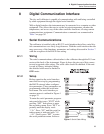
11 Maintenance
•
The calibration instrument has been designed with the utmost care. Ease
of operation and simplicity of maintenance have been a central theme in
the product development. Therefore, with proper care the instrument
should require very little maintenance. Avoid operating the instrument in
an oily, wet, dirty, or dusty environment.
•
If the outside of the instrument becomes soiled, it may be wiped clean
with a damp cloth and mild detergent. Do not use harsh chemicals on the
surface which may damage the paint.
•
It is important to keep the well of the calibrator clean and clear of any for
-
eign matter. Do not use fluid to clean out the well.
•
The dry-well calibrator should be handled with care. Avoid knocking or
dropping the calibrator.
•
For dry-wells with removable probe sleeves, the sleeves can become cov
-
ered with dust and carbon material. If the buildup becomes too thick, it
could cause the sleeves to become jammed in the wells. Avoid this build
up by periodically buffing the sleeves clean.
• If a sleeve should be dropped, examine the sleeve for deformities before
inserting it in the well. If there is any chance of jamming the sleeve in the
well, file or grind off the protuberance.
• Do not drop the probe stems into the well. This type of action can cause a
shock to the sensor.
• If a hazardous material is spilt on or inside the equipment, the user is re-
sponsible for taking the appropriate decontamination steps as outlined by
the national safety council with respect to the material.
•
If the mains supply cord becomes damaged, replace it with a cord with
the appropriate gauge wire for the current of the instrument. If there are
any questions, call Hart Scientific Customer Service for more informa
-
tion.
•
Before using any cleaning or decontamination method except those rec
-
ommended by Hart, users should check with Hart Scientific Customer
Service to be sure that the proposed method will not damage the equip
-
ment.
•
If the instrument is used in a manner not in accordance with the equip
-
ment design, the operation of the dry-well may be impaired or safety haz
-
ards may arise.
47
11 Maintenance


















